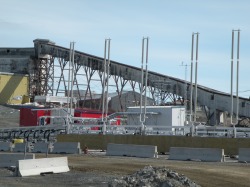Communicating with the Future

Between 1951 and 1999, the various companies that owned Giant Mine deposited 237,000 tons of highly toxic arsenic trioxide undeground. This material was collected in dust form from air pollution control equipment. At present, no known technology will allow for the safe removal of so much poisonous material, and the Canadian government has proposed freezing the material underground using thermosyphons (see photo) until safe removal methods can be developed.
What if this metarial remains as the site for a long period of time, even across multiple generations? As part of the Social Sciences and Humanities Research Council (SSHRC) funded project, Toxic Legacies, John Sandlos and Arn Keeling have written a report, Communicating Danger, that highlights key issues with the commemoration of this site in a way that warns future generations about ongoing dangers and care requirements (see also our two page summary). Sandlos and Keeling are part of a local working group in Yellowknife that is trying to develop and suggest practical strategies that could be used to communicate with future generations about the dangers of the abandoned Giant Mine.